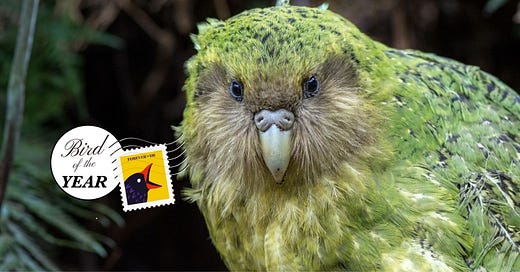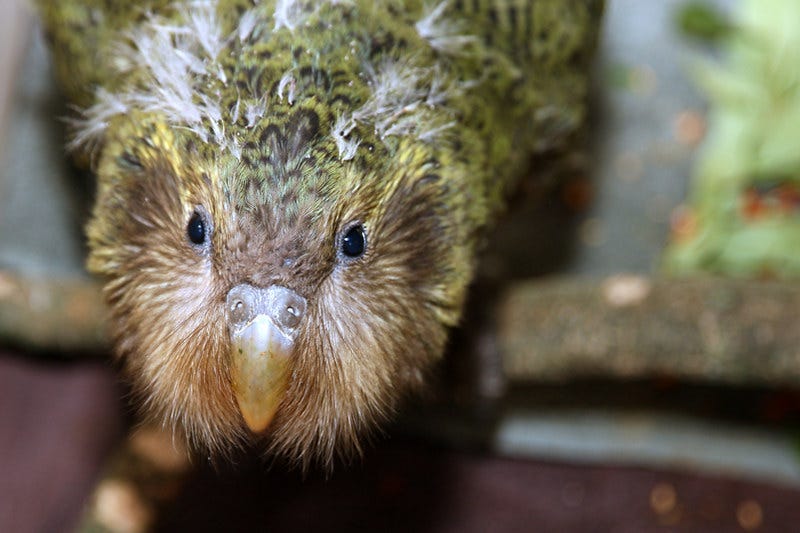Bird of the Year: Kākāpō
We might need to create a “Bird of the Decade” award for this unrivaled specimen.
This is our last post of 2024. See you in 2025!
Happy December, Discourse Blog family. I hope that as you’re reading this, you are easing yourself into a period of relative calm. It feels like a tall order to wish for much more than that, but relative calm is still a treasure and I wish only treasures for you, our sincerely beloved readers.
We are in fact here to talk about treasures. A specific treasure! The crown jewel (non-monarchically speaking, of course) of our 2024 Bird of the Week series. Yipee ki-yay motherfuckers, it’s Bird of the Year time.
This is the THIRD time I’m crowning a Bird of the Year, which feels wild to me. In 2022, our honoree was the black-naped pheasant-pigeon, a bird I selected after it was captured on camera after not having been scientifically observed in over a century. Honestly I’m still reeling from that one. In 2023, I picked a bird that had been on my radar for quite awhile: the drug-taking, safe sex icon, the great bustard. Gotta say, I feel proud of those picks! They hold up.
Now, I have to admit, I wasn’t necessarily worried about improving upon those previous title-holders. I mean come on, the entire point of Bird of the Week is that there’s seemingly no limit to the number of jaw-dropping birds out there.
So no, I wasn’t preoccupied with finding a bird—rather, I wanted a story. A news peg. A reason for the season. And as such, I refreshed myself on my favorite bird stories of the year, I did research. I also did a good amount of sighing and brow-furrowing, I looked at the lyrics “The Twelve Days of Christmas” (mental note for next year: RANK THOSE BIRDS) [ed. note: oh my god yes, holding you to that]. Then, after some exasperation set in, I consulted my ever-expanding list of BOTW contenders and found myself hovering over a name I’d considered many times before and always pushed aside purely because of a dearth of good photos: the kākāpō.
I’m getting ahead of myself, so before I get any further, yes, Discourse Blog’s 2024 Bird of the Year is: the kākāpō!!!!!!
This bird is so good that I needed to make extra sure we hadn’t covered it before. That’s when I found this comment thread from our own damn archives:
Look, aa547 and Chris, I’m sorry it took us two years to circle back on this and thank you for the full-throated recommendation. You were right!!
Here, by the way, is the video Chris was talking about (I think!) of Douglas Adams talking about the kākāpō:
This bird is unbelievable. I’ll just say right now that there is so much genuinely fascinating material to read about kākāpōs that I opened tab after tab after tab after tab while trying to write this blog and at some point both me and my computer started to fully freak out. If you are at all inclined to continue learning about this bird, trust me when I say there is so much more to learn and appreciate. But for the sake of our purposes here (again, I hope you have some relaxing you need to go do!), I’m trending toward brevity. I just need to assert that it’s not for lack of enthusiasm. It was actually incredibly difficult to cut myself off from LEARNING MORE ABOUT THIS BIRD. Okay, okay, enough. Onto the facts!
The kākāpō is a nocturnal bird that hails from New Zealand, and its name actually comes from Māori, meaning “night parrot.” Kiwis might be the iconic bird of New Zealand, but the kākāpō is right up there with them, and even appears in Māori folklore.
Kākāpōs are flightless—the only flightless parrot in the world, in fact—and they can live as long as 90 years, which makes them one of the longest-living birds on the planet. They’re also among the heaviest birds in the world (and the heaviest parrot species), weighing up to 13 pounds!! These guys rule in part because they are absolutely teeming with superlatives, but don’t care one bit. It’s as if they were crowned homecoming king and queen and Most Likely to Succeed and Best Smile and were genuinely like, “thanks, just happy to be here.”
And yet, look at them!!! They have whiskers!! This is a guinea pig with wings!!
As you can see, the kākāpō has gorgeous green feathers and a beguiling owl-like face, which it has developed over time because of its nocturnal nature. While they dwell in the New Zealand forest, kākāpōs have also been compared to ducks and penguins because of their gait. Make no mistake though, while kākāpōs can’t fly, they have beautiful sturdy legs and are mighty good climbers.
Kākāpōs are often described as truly unique, an oddity, one of the strangest and rarest birds in the world, and that is not inaccurate! Aside from simply having a wealth of quirky characteristics, they have no close relatives, which makes their critically endangered status all the more alarming. After having existed peacefully on Earth for millions of years, with few natural predators to speak of, kākāpōs became royally fucked with the arrival of humans several hundreds of years ago. We weren’t just predators ourselves, we brought predators with us, and soon, these tame and mild creatures with no previous need for defensive skills were almost entirely wiped out.
In recent years, extensive conservation efforts have yielded small but significant wins and as of 2024, a few hundred kākāpō exist on islands away from mainland New Zealand, where they are studied and cared for. I highly recommend following Kākāpō Recovery to keep up with the latest and fill your feed with the cutest bird known to man.
Okay, I purposefully did not want to end this blog on a sad note so I saved the best for last: sex. Let’s get this video—which seems to make its way into my feeds every few months—out of the way. And yes, “shagged by a rare parrot” will always make me laugh:
Despite what this clip might have you believe, kākāpōs are not championship lovers. But like their gentle nature, that fact is a product of circumstance! Back when they didn’t have terrestrial predators, these birds didn’t need to churn out offspring to keep the species alive. As such, they evolved to mate slowly, with females only looking to breed every few years. Kākāpōs are also the only lek-breeding parrot in the world, and boy do they have quite a courtship ritual.
In short, males attract females by being loud as hell (listen here!). They hit both ends of the aural spectrum, making deep, booming calls that can travel for literal miles, as well as a high-pitched “ching.” I will not be making any endurance jokes here, just adding that they will boom and ching all night long in their quest to bag a mate, which is either desperate, romantic, or both. No judgment here, fellas.
I told myself I’d stop after 1,000 words about the kākāpō and I’ve gone well beyond that so I’ll cease the praise train now. I should note that kākāpōs were named New Zealand’s bird of the year in 2020 (it was also New Zealand’s bird of the year in 2008), so we are not the first to bestow such an honor and I don’t suspect we’ll be the last. For now, enjoy the dulcet tones of Benedict Cumberbatch telling you even more facts about this incredible creature.
See you again next year, bird freaks. Live long, and bird on. Caw-caw!
Please do keep sending us your favorite birds at hello@discourseblog.com and we WILL get to them, even if it takes years. And remember, you can always check out our complete Bird of the Week list here.









Much love for repping the Kea's weird cousin. 31 birds just realized they'll be fighting over a silver medal in a few months.
The look on Sirocco's face when he's going to town on Mark Carwardine's head is genuinely one of the most perfect and wonderful thing's I've ever seen, and I will never pass up an opportunity to watch that clip :D